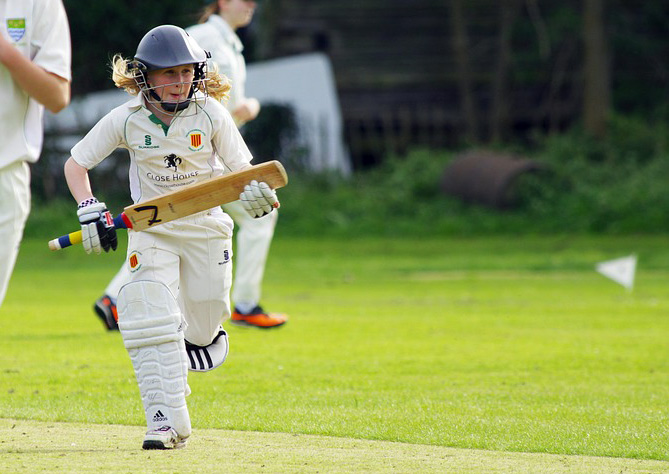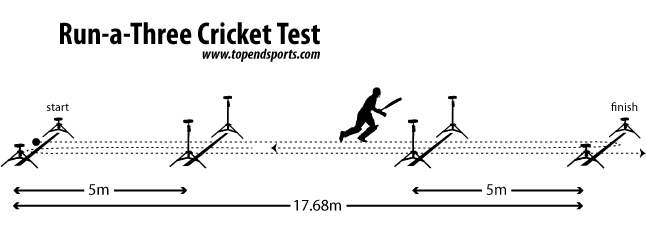Running speed, acceleration, and agility are very important physical attributes for cricket players, particularly for moving between the wickets and when fielding. The Run-a-Three Test is a cricket fitness test that assesses both speed and agility in a very specific cricket situation (see also the similar Run 2 Cricket Test). The run-a-three involves sprinting over the actual pitch distance three times, carrying a bat and incorporating two 180 degree turns. This test not only assesses speed, but also technique on the turn and running the bat in at the end.
 running between wickets in a cricket match
running between wickets in a cricket matchtest purpose: The aim of this test is to determine the running speed up and down the cricket pitch while wearing cricket equipment.
equipment required: timing gates or stopwatch, non-slip running surface, tape for marking the ground and cone markers.
pre-test: Explain the test procedures to the subject. Perform screening of health risks and obtain informed consent. Prepare forms and record basic information such as age, height, body weight, gender, test conditions including the running surface. Measure and mark out the test area. Perform an appropriate warm-up. Set up and test the timing gates. See more details of pre-test procedures.

test setup: If the test is not performed on a cricket pitch, then lines marking the creases need to be made 17.68 meters apart. If using timing gates, they are set up at the line of the popping (batting) crease at each end, and also 5 meters before each crease. Set the center timing gates at a height of 1.2 m to be activated with the torso, and at each end the timing gates are to be lowered to a height of 0.06 m so that a sliding bat would break the beam.
procedure: The run-a-three test involves three repeated maximal sprint trials to be performed over the same distance as between the batting creases on a cricket pitch (58 feet or 17.68 meters). The players carry their cricket bat (and can also be wearing cricket kit such as pads and helmet). They start running from one end, run to the other crease where they turn and run back to the starting line, turn again then run through the final line. The starting position is with the foot over the starting line with the bat in hand. Players should slide the bat over the crease mark at each end when turning and at the finish.
results: Three trials are allowed. Record the time for each straight run (58 feet / 17.68m), and total time for the run-a-three. Turning time for the changes of direction between runs 1–2, and 2–3 can also be recorded (timed from when the subject passes through the timing gate 5 m away from the crease, until they return through the same timing gate).
target population: cricket players of all levels.
variations: you could also measure running speed for run-a-two, and also a straight 17.68m quick single.
comments:
- The participants are required to keep the bat in their dominant hand throughout the test.
- If timing gates are not available, use a stopwatch to record the time from start to finish.
- Wearing pads and helmet adds to the cricket specificity of this test.
- The distance from stumps to stumps is 22 yards / 66 feet / 20.12m, with the popping crease at each end 4 feet (1.22m) from the stumps. Therefore, from crease to crease is 66 - (2 x 4) = 58 feet, or 17.68 meters.
references:
- Bourdon P., Savage B. and Done R., Protocols for the Assessment of Cricket Players. Physiological Tests for Elite Athletes, Australian Sports Commission, (2000)
- Lockie, Robert G.; Callaghan, Samuel J.; Jeffriess, Matthew D. Analysis of Specific Speed Testing for Cricketers Journal of Strength and Conditioning Research: November 2013 - Volume 27 - Issue 11 - p 2981–2988
- Houghton, L. A. (2010). Running between the Wickets in Cricket: What is the Fastest Technique? International Journal of Sports Science & Coaching, 5(1), 101–107.
Similar Tests
- Run 2 Cricket Running Speed Test — a cricket speed and agility test, involving sprinting the length of a cricket pitch twice.
- 5-0-5 Agility Test — run 5m and back, testing 180 degree turning ability.
- Straight 17.68m Sprint — running speed test over the length of a standard cricket wicket.
Related Pages
- More about fitness testing for cricket
- General information about Sprint or Speed Testing
- Training for speed
- Warming up for sprint testing
- Other anaerobic tests and about anaerobic testing
- Fitness for Cricket
- We have listed some suggested tests for testing cricket players.
- Cricket Training Programs
- Fitness Components for Cricket
- Discussion about Who Is The Fittest Cricket Player Ever?


 Current Events
Current Events